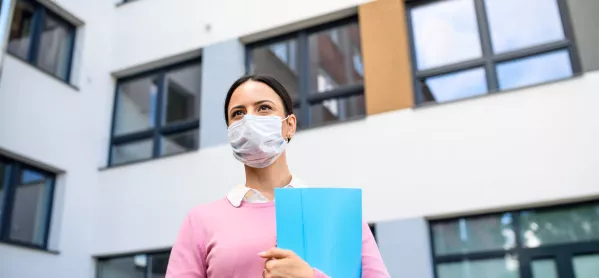‘Highly likely’ teacher Covid rates higher than average

It is “highly likely” that Covid rates among teachers are higher than the wider adult population, new analysis shows.
But updated data on relative risk by occupation is needed to confirm this, according to a report published today by the Education Policy Institute (EPI) think tank.
The EPI also found that absence rates based on confirmed cases of the coronavirus were six times higher for teachers than for pupils in primary schools, and up to three times higher for teachers in secondary schools.
Analysis: Why are primary teachers being hit extra hard by Covid?
NEU: Teachers ‘almost twice as likely to get Covid’
Staff absence: 20,000 teachers off for Covid-related reasons
Around 0.5 to 0.9 per cent of primary teachers were absent due to a confirmed Covid case during the autumn term, compared with 0.05 to 0.15 per cent of primary pupils.
And the rate for secondary teachers was roughly 0.6 to 1 per cent, compared with 0.2 to 0.3 per cent for secondary students.
Coronavirus: Teachers ‘must be given priority for vaccine’
The report says that it is “highly likely” that confirmed coronavirus case rates among teachers are higher than the adult average - but more data is needed to confirm this.
“Unfortunately, it is not possible to undertake a precise comparison between confirmed cases among teachers and the general population because the school survey captures a different concept (absences resulting from confirmed cases at a point in time) than general testing data (the proportion testing positive over the past day or week),” it said.
“There are, however, strong reasons to believe that the rate of confirmed cases amongst teachers is higher than amongst all adults or the general population.”
The report looks at data from the Office for National Statistics (ONS), which estimated that the share of the population testing positive for coronavirus, including symptomatic and asymptomatic cases, was around 0.8 to 1.2 per cent over a period from mid-October to mid-December.
It compared this with the government’s daily Covid testing data, which showed around 0.2 to 0.4 per cent of the population testing positive for coronavirus each week over the same period.
“Actual infections are therefore much higher than positive cases in testing data, largely due to a high number of unidentified, asymptomatic cases,” the report says.
“Given that we see 0.5 to 1 per cent of teachers absent due to a confirmed, positive case (highly likely to capture most symptomatic cases), it seems highly likely that the total number of infections amongst teachers is higher than amongst the rest of the population (0.8 to 1.2 per cent). By how much is not clear.”
Luke Sibieta, research fellow at the EPI, said: “This research shows that a far greater share of teachers missed school due to a positive Covid test compared with pupils. We find that Covid absence rates in England were three times higher for teachers than for pupils in secondary schools and six times higher in primary schools - though there was significant variation across the country.
“Our analysis indicates that teachers are likely to have seen higher Covid case rates than the adult population as a whole - but we need to see more data released by the government in order to confirm this, and to inform any forthcoming decisions on vaccination prioritisation. The government should be looking at this very closely ahead of the potential reopening of schools next month.”
Geoff Barton, general secretary of the Association of School and College Leaders, said: “It is very worrying to see research which suggests that teachers are at greater risk of contracting coronavirus than the wider population, and there is clearly a moral imperative to prioritise the education workforce for vaccinations.
“Schools and colleges have worked extremely hard to create environments which are as safe as possible, but the reality is that, when fully open, they are inherently busy and crowded places, and high infection rates in the wider community inevitably mean more risk.
“The government must commit to prioritising education workers in the next phase of the vaccination programme and it must set out a clear timetable. In particular, it must prioritise staff in specialist settings whose roles are often akin to those of care workers.”
Paul Whiteman, general secretary of school leaders’ union the NAHT, said: “We have been calling for school staff to be prioritised for vaccinations for some time and we believe this new analysis shows that the government should now confirm that it will take this step.
“This data shows that absences due to Covid are almost certainly higher for school staff than other adults generally and that each staff absence has an impact on dozens of pupils at a time.
“Vaccinating the workforce therefore has the dual benefit of protecting their health whilst also preserving the education of their pupils. It is difficult to see any reason not to vaccinate staff now.”
You need a Tes subscription to read this article
Subscribe now to read this article and get other subscriber-only content:
- Unlimited access to all Tes magazine content
- Exclusive subscriber-only stories
- Award-winning email newsletters
Already a subscriber? Log in
You need a subscription to read this article
Subscribe now to read this article and get other subscriber-only content, including:
- Unlimited access to all Tes magazine content
- Exclusive subscriber-only stories
- Award-winning email newsletters